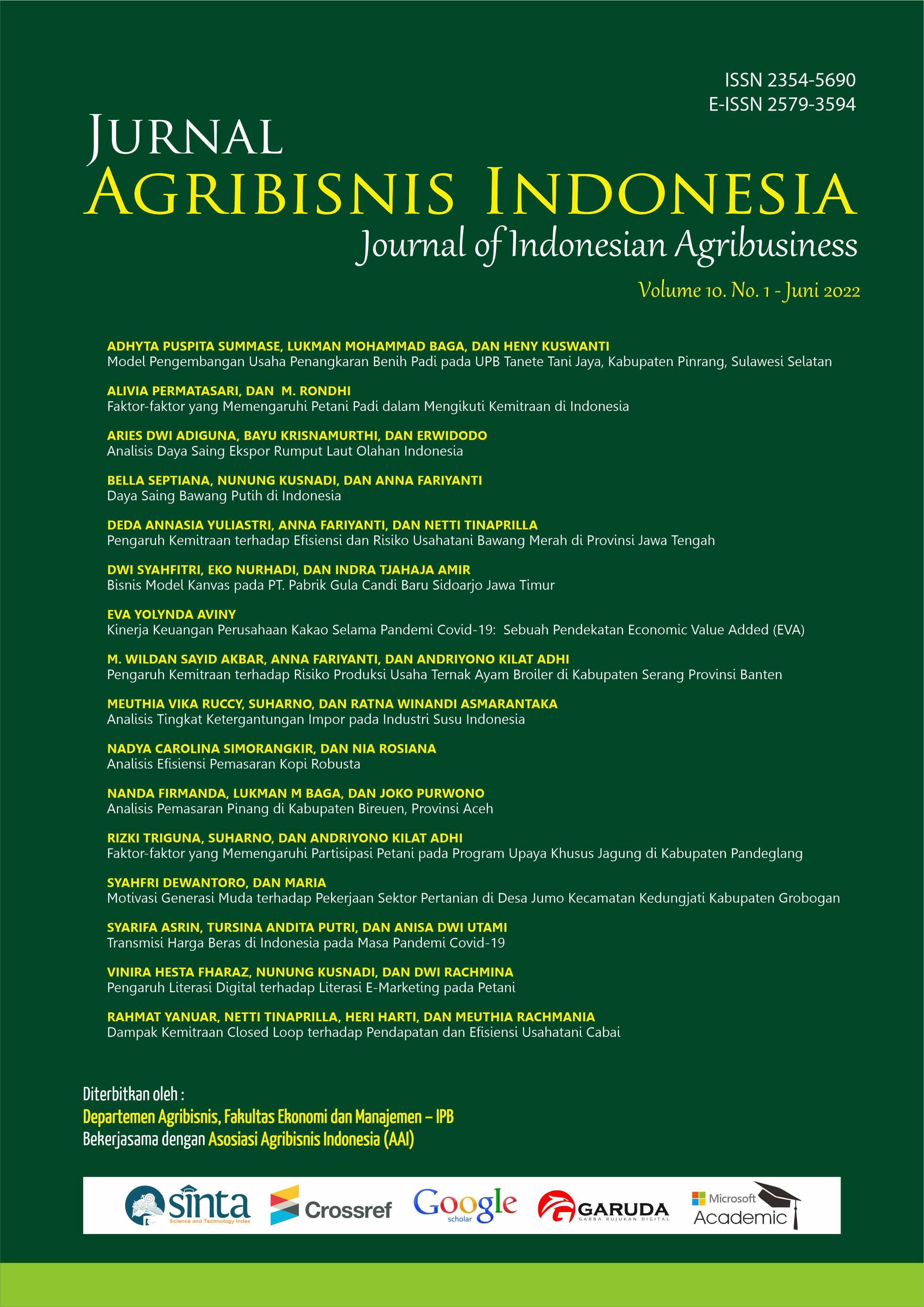Analisis Efisiensi Pemasaran Kopi Robusta
Main Article Content
Abstract
Robusta coffee is a leading commodity in West Lampung Regency. The existence of a gap in coffee prices at the producer and consumer level by 49,04 percent is suspected that a large number of marketing institutions are involved, resulting in high marketing costs. This has led to allegations of unequal pay among marketing institutions. It has an impact on the level of coffee marketing efficiency in the Sekincau District. Therefore, this study aimed to analyze the Robusta coffee marketing system that is formed, based on the institutions involved, and analyze the Robusta coffee marketing efficiency in Sekincau District. Research data was obtained from observations, interviews using questionnaires, and supporting data from relevant agencies. The results showed that four marketing channels carried out each marketing function. Based on quantitative calculations, channel I is the most efficient channel with a margin of Rp 5.669 per kg and a farmer’s share of 76,77 percent. Efforts to overcome coffee marketing inefficiencies in Sekincau District, West Lampung Regency through the optimal implementation of marketing functions at each marketing agency, efforts to improve post-harvest quality and sales of coffee products that have been processed into sangria coffee or powder to encourage increased selling prices and farmers' income.
Downloads
Article Details

This work is licensed under a Creative Commons Attribution 4.0 International License.
Jurnal Agribisnis Indonesia (JAI) is an Open Access Journal. The authors who publish the manuscript in this journal agree to the following terms:
Creative Commons License
JAI is licensed under a Creative Commons Attribution 4.0 International License. This permits anyone to copy, redistribute, remix, transmit, and adapt the work provided the original work and source are appropriately cited.
This means:
(1) Under the CC-BY license, authors retain ownership of the copyright for their article, but authors grant others permission to use the content of publications in Jurnal Agribisnis Indonesia in whole or in part provided that the original work is properly cited. Users (redistributors) of JAI are required to cite the original source, including the author's name, JAI as the initial source of publication, year of publication, volume number, issue, and Digital Object Identifier (DOI); (2) Authors grant JAI the right of first publication. Although authors remain the copyright owner.
References
Asmarantaka, RW., Tinaprilla, N., Rifin, A., dan Herawati. 2015. Kajian pemasaran dan rantai pasok kopi di Provinsi Lampung. Laporan Penelitian Unggulan Departemen Agribisnis, FEM IPB.
Baroh, I., Hanani N., Setiawan, B., dan Koestiono D. (2014). Indonesian coffee competitiveness in the international market : Armington Model Application. American Journal of Economics, 4(4), 184-194.
Boansi, D., dan Crentsil, C. (2013). Competitiveness and determinants of coffee exports, producer price and production for Ethiopia. Journal of Advanced Research in Economics and International Business, 1(1), 31-56.
[BPS] Badan Pusat Statistik Indonesia. 2019. Statistik Kopi Indonesia 2018. Badan Pusat Statistik Indonesia. Jakarta.
[BPS] Badan Pusat Statistik Kabupaten Lampung Barat. 2019. Kabupaten Lampung Barat dalam Angka 2019. Badan Pusat Statistik Kabupaten Lampung Barat. Liwa.
[BPS] Badan Pusat Statistik Kabupaten Lampung Barat. 2019. Kecamatan Sekincau dalam Angka 2019. Badan Pusat Statistik Kabupaten Lampung Barat. Liwa.
[BPS] Badan Pusat Statistik Provinsi Lampung. 2017. Statistik Harga Konsumen Kota Bandar Lampung 2017. Badan Pusat Statistik Provinsi Lampung. Bandar Lampung.
[BPS] Badan Pusat Statistik Provinsi Lampung. 2017. Statistik Harga Produsen Pertanian Provinsi Lampung (Subsektor Tanaman Pangan, Hortikultura, Tanaman Perkebunan Rakyat, Peternakan, dan Perikanan) 2017. Badan Pusat Statistik Provinsi Lampung. Bandar Lampung.
Desiana, C., Rochdiani, D., dan Pardani, C. (2017). Analisis Saluran Pemasaran Kopi Robusta Studi Kasus di Desa Kalijaya Kecamatan Banjarsari Kabupaten Ciamis. JIM Agroinfo Galuh. 4(2), 162-173.
[DITJENBUN] Direktorat Jenderal Perkebunan Kementerian Pertanian. 2019. Statistik Perkebunan Indonesia Komoditas Kopi 2018-2020. Jakarta: Direktorat Jenderal Perkebunan.
[PUSDATIN] Pusat Data dan Sistem Informasi Pertanian Sekretariat Jenderal Kementerian Pertanian. 2018. Outlook Kopi 2018. Jakarta: Portal Epublikasi Pertanian.
[PUSDATIN] Pusat Data dan Sistem Informasi Pertanian Sekretariat Jenderal Kementerian Pertanian. 2019. Buku Outlook Komoditas Perkebunan Kopi 2019. Jakarta: Portal Epublikasi Pertanian.
Pratiwi, AM., Kaskoyo, H., dan Herwanti, S. (2019). Efisiensi Pemasaran Akroforestri Berbasis Kopi Berdasarkan Keragaan Pasar : Studi Kasus di Pekon Air Kubang, Tanggamus. Jurnal Sylvia Lestari, 7 (3), 299-308.
Hanafiah, AM., dan Saefudin, AM. 1983. Tataniaga Hasil Perikanan. Jakarta: Universitas Indonesia (UI) Press.
Herawati. 2017. Analisis Tataniaga Nenas Palembang (Kasus Desa Paya Besar, Kecamatan Payaraman, Kabupaten Ogan Ilir, Provinsi Sumatera Selatan) [skripsi]. Bogor: Institut Pertanian Bogor.
Hutama. 2018. Efisiensi Pemasaran Jamur Tiram di Kabupaten Bogor [skripsi]. Bogor: Institut Pertanian Bogor.
[Kemendag] Kementerian Perdagangan RI. 2015. Perkembangan Perdagangan Indonesia-Perancis Periode Januari-Februari 2015. http://www.kemendag.go.id/files/pdf/2015/08/13/report-1439431761.pdf. [21 Desember 2017].
Nugroho A. (2014). The impact of food safety standard on Indonesia’s coffee exports. Procedia Environmental Sciences. 20, 425–433.
Otim, S., dan Ngategize, PK. (1993). Uganda coffee supply response and export demand: an econometric analysis. African Crop Science Journal, 1(2), 175-182.
Rosiana, N. (2020). Dinamika Pola Pemasaran Kopi pada Wilayah Sentra Produksi Utama di Indonesia. Jurnal Agrosains dan Teknologi. 5(1):1-10.
Rosiana, N. 2019. Dayasaing dan Ekspor Kopi Indonesia melalui Pendekatan Sistem Dinamis [disertasi]. Bogor: Institut Pertanian Bogor.
Rosiana, N., Nurmalina, R., Winandi, R., dan Rifin, A. (2018). Dynamics of Indonesian Robusta Coffee Competition Among Major Competitor Countries. Journal of Industrial and Beverage Crops, Indonesian Center for Estate Crops Research and Development. 5, 1-9.
Rosiana, N., Nurmalina, R., Winandi, R., dan Rifin, A. (2017a). Efficiency Analysis of Indonesian Coffee Supply Chain Network Using A New DEA Model Approach: Literature Review. Asian Social Science. 13, 158-166.
Rosiana, N., Nurmalina, R., Winandi, R., dan Rifin, A. (2017b). The Level of Comparative Advantage of World Main Coffee Producers. Trade Analysis and Development Agency Ministry of Trade, Republic of Indonesia, 11, 227-246.
Sugiarti S. (2010). Analisis Pemasaran Kopi di Kecamatan Bermani Ulu Raya Kabupaten Rejang Lebong. Jurnal Agrisep, 9(1), 130-136.

